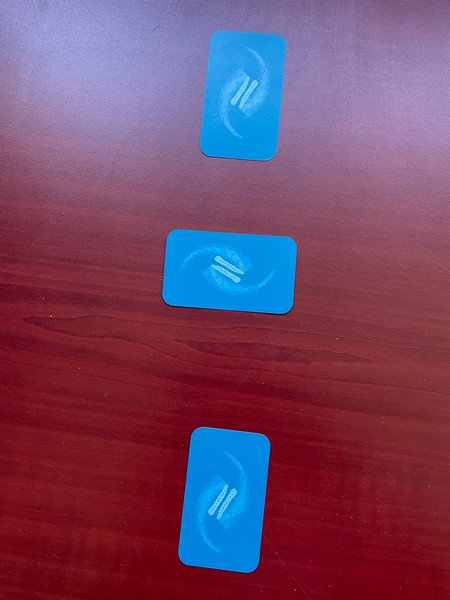Dude! Take Your Turn!
A Gaming Life
Kickstarter Review – Like Cain and Abel

I like card games a lot.
Short, punchy 2-player card games are even better, as you don’t need a lot of time and they work in almost any circumstance.
Even better is when they do some innovative things with the whole genre.

Like Cain and Abel is an 18-card, 2-player trick-taking game designed by, with artwork by, and published by J.L. Reid. It’s going to Kickstarter on April 30 and the campaign is running until May 23.
J.L. graciously offered me a prototype copy of the game in exchange for a fair an honest review, and I jumped at the chance.
Keep in mind, though, that since this is a prototype, the components will change some, especially from a quality perspective. The pictures below don’t represent the final product.
How is Like Cain and Abel innovative and how does it get in its own way, at least a bit?
Let’s take a look.
There are a number of cool things about the game that I actually really enjoyed.
A 2-player trick-taking game where the tricks consist of 3 cards?
Check!
A trick-taking game where the round can end in the middle of a trick?
Check Check!
Cards that can be different “suits” and values depending on how you play them?
Check Check Check!
A game where the number of cards in the round grows less and less, and three of the cards are always out of the game?
Check Check Check Check!
What’s that last bit?
Let’s start at the beginning. Remember, there are only 18 cards in the entire game.
Three of them are going to be each player’s Offering Basket and then the Offering Stone that’s between them.

That leaves 15 cards.
Let’s examine the cards a little bit.

Each card has two values and two Offerings: Blood and Harvest.
Which Offering and value it is depends on its orientation toward the Offering Stone.
Each round, players will be dealt all of the remaining cards, with the non-dealer getting the extra card. They will then each choose a secret Covenant that they are making, either Blood or Harvest, and place the card with that Offering value facing the Offering Stone, like so (though it will be secret, fully placed under the Offering Basket, the picture is just so you see what I’m talking about).

The value is also the number of points you will receive if you make your Covenant.
That’s 2 more cards out of the game, for this round anyway.
The Covenant is basically you saying that you will take more cards of that Offering than your opponent.
Not only that, but you also must have taken more cards of that Offering than the other Offering.
Then the tricks begin!
The non-dealer will play the first card in the trick, orienting it so that the value and Offering is facing the Offering Stone.
The second player has to play a card of higher value, regardless of Offering, if they can.
If they do, they place it on top of the first card, with the value and Offering oriented to the Offering Stone.
If they can’t, they play any card they want face-down.
Then the first player plays the third card, which must be a higher value if it’s played face-up. They can play face-up or face-down, depending on what they want to do.

Maybe the second player played face-down and the only card they have that is higher is an Offering they don’t want to win? Then they can play the card face-down instead. Or if they want to add to their Harvest Offering (above), then playing a second one would be good, even though they’re winning the trick already.

Face-down cards are discarded while face-up cards are taken by the winner of the trick and placed in front of them, oriented so that the Offering is toward the Offering Stone.
I love the idea of a 3-card trick, where the person who led the trick gets an opportunity to win it if the second player played a card. That’s so unusual.
Of course, this means that the loser of the trick leads the next one, just to be fair.
Unfortunately, it also leads to the one main stumbling block in the game, at least for me and the person who tested it with me.
The orientation of the cards and how to play them was just really hard to keep straight at times.
What seems natural to me, and is backed up by the rulebook, is that when leading the trick, I play it in front of me, oriented toward the Offering Stone.
Then the other player has to reach across the table, twisting their card around (if it’s going to be played face-up anyway) and playing it that way. Or they have to hand the card to me and I have to place it down.
Then whoever wins the trick has to remember to orient the cards correctly to match what was played, as they are keeping the Harvest and Blood offering cards separate.
It just seemed like a lot of trouble for what is a very quick and light card game.
Heaven forbid that one of you accidentally turns the card the wrong way when grabbing it.
Anyway, this continues until one player runs out of cards and can’t play when they are supposed to.
The round immediately ends, even in the middle of the trick.
Players count up the number of Offerings of each type they have, and each reveals their Covenant.
If there is a tie for the number of Offering cards won, you count the number of flames on all the cards you won, and whoever has the most wins it.
Did they make it? Do they have more of that Offering than the other player, and more of that Offering than the other Offering?
If so, they put their favour token on the non-scoring value of the card and place it in front of them.
Favour token?
Oh yeah, at the beginning of each round, prior to making their Covenant, each player draws a favour token. Eight of them are “in favour” while the other four are “out of favour”.

You keep hidden each round whether you were in favour or out of favour (again, the picture above is just so you know what I’m talking about, but they are technically face-down), but if you were out of favour, those points will not count for you at the end of the game.
If you didn’t make your Covenant, then your Covenant card is discarded along with the favour token. Otherwise, it’s kept.
All of the discarded cards and remaining cards (including what was in a player’s hand at the end of the round, but not any incomplete trick) are shuffled and redealt.
Yes, that does mean that there are fewer and fewer cards in each round, which again, I love!
There’s also an element of boasting and bluffing to the game, at least a little bit.
Once you’ve set your Covenant, each player can boast that they will win the most Offering cards of a certain type, and that their Covenant is of that type. Just place your meeple on one side of the marker or the other.

You better remember what colour you are! The meeple is the only indication.
You could be bluffing, making your opponent think you want one type of Offering when you really want the other.
Or not.
If you made your Covenant and boasted that same Offering, then you made your boast!
What do boasts do?
They can get you the Last Act token.
What does that do?
Whoever has it at the end of the game can cancel out one of their opponent’s scoring cards (as long as they have at least two in play…because that would just be smashing a mosquito with a hammer otherwise).
That does seem rather punitive, but it could be a catch-up mechanism if you are falling behind in revealed points.
Of course, you don’t know if you are truly behind because maybe your opponent drew all “out of favour” tokens!
The game last 5 rounds, with cards getting shed from play as they are scored (unless both players suck at making Covenants) meaning that subsequent rounds could get really short.

I really do like the dual nature of the cards, and how the values can be so different depending on the Offering.
The fact that the second player has to play a higher value makes it a really interesting choice for the leader. Do they play a middle card, knowing that it will force the other player to play a card (given the nature of the cards, there’s almost no way they won’t have something to beat a seven, for instance).
Do you lead high so you force them to shed a card face-down instead? But then you won’t win that card for your Covenant.
The strategy is really interesting, especially given how small the deck is (remember, you’re only going to have 13 cards in the first round, much less subsequent rounds when more cards are gone).
That last part actually is another minor issue, given the few number of cards.
Going over five rounds, the final round could be really short.
If all players complete their Covenants in the first four rounds, that leaves only 5 cards left for the final round.
Thus, the final round (and sometimes even the 4th round, though not quite as much) can be almost programmed because there’s not a lot of choice in what to play. One player has 3 cards and the other player has 2.
Granted, it’s not that likely to happen where everybody makes their Covenants, but there are still likely to be so few cards left that the choices aren’t that interesting.
I would almost say that the game should either be a round shorter or have a few more cards in it.

There is so much cool about this game that I want to like it more than I do.
Three-card tricks, I wonder why nobody has done this before? (This is where somebody pipes in and says that a lot of games do it and I’m just stupid and ill-informed).
Cards that are out of play but actually serving some kind of purpose?
It’s like letting your little brother who isn’t old enough to play Power Grid be the bank, handing out money.
If you’re just not using something, make them useful in other ways!
I like the uncertainty of the favour tokens.
Did my opponent just score an 18-point Blood Covenant?
Or were they out of favour when they did and it’s all moot? (though why they would play an 18-point card if they were out of favour is beyond me…sounds like something I would do).
However, the orientation requirement just makes the game more fiddly than a light game like this should be, and the final round or two just aren’t that interesting with so few choices left to make.
Speaking in baseball terms, consider this one a single when I so much wanted it to be a triple or even a home run.
If the game sounds interesting to you, though, go to the Kickstarter page and be notified when it launches on April 30!
And if you’re reading this after May 23, then sorry, you missed out.
But you may be “abel” to track it down somewhere.
See what I did there?
